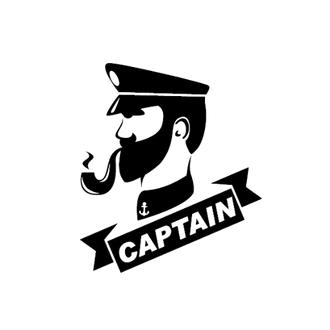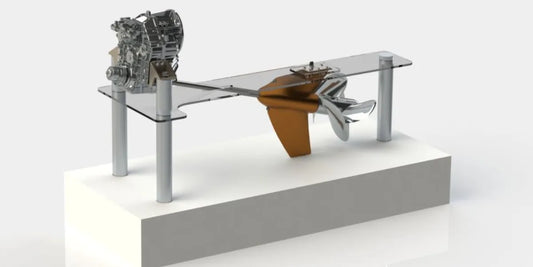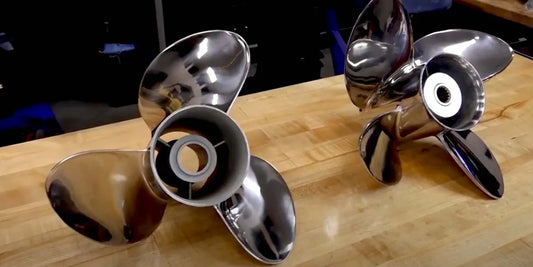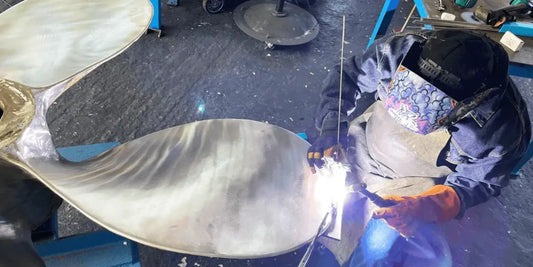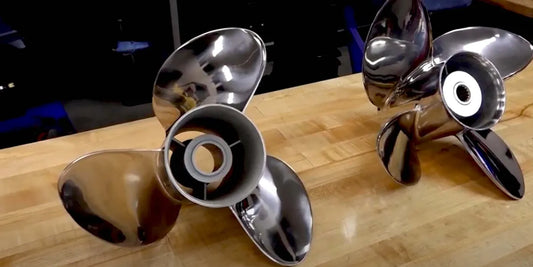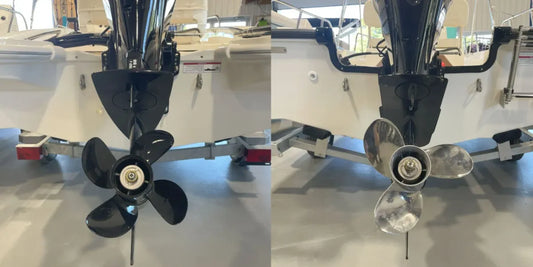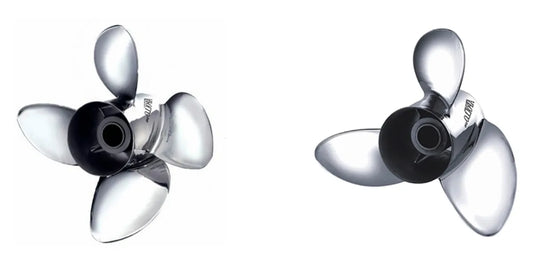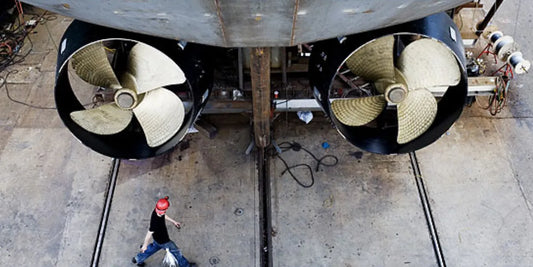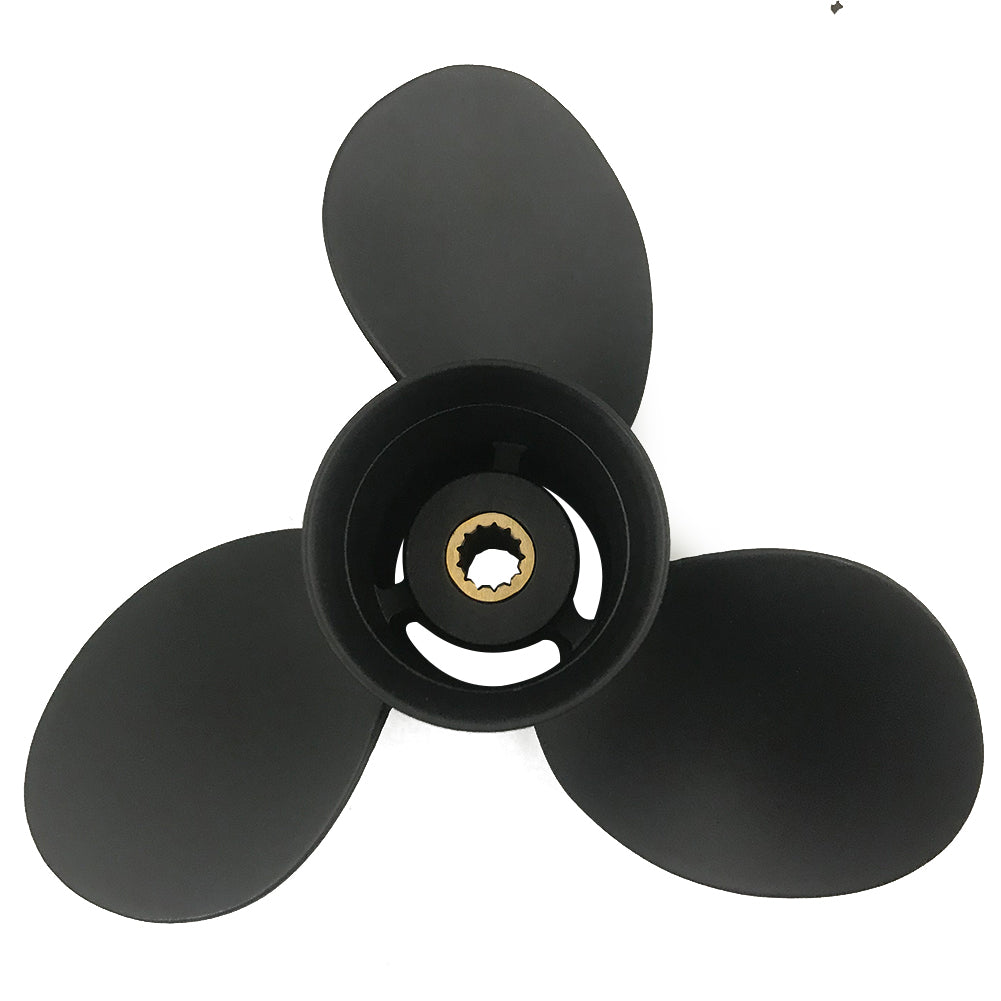Selecting the correct propeller for a ship is a critical task. Very often, choosing a propeller of an incorrect type might have a significant influence on the ship’s productivity, controllability, and fuel efficiency, and accordingly, its market cost. One of the key factors in this selection is the choice of a left- or right-hand propeller and its number of blades. But what does this variation mean, and how does it change the boat trip experience? This guide explains the differences in construction and use of left- and right-handed propellers, as well as the factors to consider when choosing the most suitable propeller. If you are a well-seasoned captain or an amateur who wants to improve in terms of your enhancement, this post will sufficiently educate you to be able to make a choice that is most fitting to your requirements.
Understanding Propeller Basics

What is a Propeller?
A propeller is a device designed to transform rotational energy into force, which in turn moves the vessel through the water. With blades arranged around a central hub, a propeller operates according to the principles of fluid mechanics. When rotated, the blades push against the water, creating a pressure difference: a higher pressure behind and a lower pressure ahead, which, in essence, equals forward thrust. Metal steels and composites, aluminum, and other materials are the usual materials from which propellers are made. Propellers must be engineered with precision to achieve performance factors such as speed, fuel economy, and maneuverability. Paramount features of any propeller include diameter, pitch (theoretical distance the propeller would move in one revolution), number of blades, and rake angle; all of these have a direct bearing on the handling characteristics of the vessel and propulsive efficiency. Knowledge of the above factors is crucial in selecting the appropriate propeller for various operational needs.
Types of Propellers: Right Hand vs Left Hand
The rotational direction of a propeller is typically used to classify propellers as either right- or left-handed. If it turns clockwise when viewed from the back of the vessel, it is said to be a right-hand propeller; when it turns counterclockwise, it is called a left-hand propeller. The decision to choose one over the other depends on the vessel's propulsion system and its specific operating requirements.
Typically, right-hand propellers are established as the standard, preferred for maintaining the same rotation direction in single-engine setups. When left-hand propellers are paired with right-hand propellers in a twin-engine arrangement, the goal is to counteract torque effects, thereby balancing thrust and enhancing maneuverability.
The distinction between these two types also affects the thrust of the vessel and handling characteristics when in use. For example, the most critical aspect in selecting the propeller-cum-marine gearbox combination is the direction of rotation. Any mismatch would result in a loss of efficiency and strain on the propulsion system. Using advanced materials and precise engineering, right- and left-hand propellers have been tailored for specific operating conditions, achieving the best hydrodynamic efficiency and minimizing vibrations in vessels.
Regarding Propeller Rotation and Performance
The relationship between propeller rotation and vessel performance requires an in-depth study of hydrodynamic forces and propulsion dynamics. Water flow patterns, thrust, and vessel stability vary according to the propeller's setting, which can be either right-hand or left-hand. For instance, the right-hand propeller rotates clockwise (from the perspective of viewing from astern), applying a force known as the transverse thrust effect, which may cause slight yawing of Titan during low-speed turns or when docking.
Research has shown that counter-rotating propellers, typically fitted in a twin-engined configuration to counteract the tendency of torque imbalance and ideally balance the flow of water aft of the hull, can reduce cavitation, thereby enhancing fuel efficiency and providing significant support to vessel handling in adverse weather conditions. Furthermore, state-of-the-art CFD simulations and model tests have demonstrated that optimizing blade pitch and rotation speed according to a specific operational profile can significantly reduce vibration and noise levels while increasing propeller efficiency by over 10%.
Having the hull and propulsion system come first in design, and then adjusting the direction of propeller rotation, allows engineers to maximize operational performance, reduce component wear, and enhance all sustainability parameters, demonstrating the critical importance precise tuning plays in modern marine propulsion technology.
Right Hand vs Left Hand Propeller: Key Differences

Characteristics of Right-Hand Propeller
A right-handed propeller has a clockwise rotation when viewed from the stern of the vessel. This arrangement of the propeller is commonly used in single-screw ships and significantly impacts the ship's maneuverability. The clockwise rotation imparts a lateral force called transverse thrust or propeller walk, which, in typical circumstances when moving ahead, results in a slight pull of the stern of the vessel toward port.
Technically speaking, right-hand side propellers derive their efficiencies from factors such as blade pitch, diameter, and construction material. Newer advances in materials, such as cast stainless steel and nickel-aluminum bronze alloys, have been used to enhance durability and provide corrosion resistance in marine environments. With regard to blade geometry, CFD simulation has shown that depending on the operating conditions of a vessel, there lies an opportunity of approximately 5-8% increase in thrust ratio with optimization of blade geometry.
The right rotation of propellers requires hull designs and rudders that are carefully crafted to be in concert with them, in order to prevent or minimize cavitation and hydrodynamic losses; this is a crucial engineering exercise. This is frequently compensated for by a left-hand propeller on a twin-screw vessel, which balances the forces to enhance navigational stability and fuel efficiency. A thorough understanding of the intricacies involved goes a long way toward improving propulsion and extending the working life of marine vessels.
Features of Left-Hand Propellers
The left-hand propeller rotates in a counterclockwise direction as viewed from the stern of the ship proceeding forward. This rotation influences the flow dynamics around the propeller, including wake patterns and symmetry of thrust. Generally, a left-hand propeller is employed in conjunction with a right-hand propeller on twin-screw ships to maintain cancellation of torquing effects imposed by opposite rotational directions.
Material construction is a critical factor, with modern left-hand propellers often engineered from highly durable alloys, such as nickel-aluminum bronze, to withstand cavitation-induced wear and corrosive marine environments. Advanced computational fluid dynamics (CFD) models are increasingly used to optimize blade shape and pitch angles, thereby ensuring the highest efficiency and lowest noise profile under various load conditions.
When matched with specific hull forms, the left-hand propeller contributes to increased vibration levels and rougher maneuverability. Moreover, studies have yet to verify that the balanced use of left- and right-hand propellers can enhance fuel consumption by 5-10% compared to single-screw arrangements. Such micro-engineering data helps optimize marine propulsion systems installed on both commercial and recreational vessels.
Comparative efficiency analysis between left-hand and right-hand propellers
The operational environment, hydrodynamic aspects, and vessel configurations actually govern the efficiency of left-hand and right-hand propellers. When fitted within a twin-screw propulsion system, the counter-rotation of left- and right-hand propellers reduces rotational losses, thereby achieving real outward thrust with the lateral force on the hull being equated. For example, CFD has indicated that a twin screw can experience thrust efficiencies 15% higher than those of a single screw.
The material composition and blade geometry are also crucial for performance. The most state-of-the-art propeller designs, which employ materials such as nickel-aluminum bronze, offer the best corrosion resistance and durability, thereby guaranteeing the most extended service life in various marine environments. Additionally, an accurate adjustment of blade pitch enables these propellers to mitigate the risk of cavitation while maximizing propulsion efficiency.
Real-world trials and tests conducted under controlled conditions on vessels equipped with left-hand and right-hand propellers have yielded measurable decreases in vibration frequencies and an improvement in steering stability. This dual mechanism thereby enhances fuel consumption and vessel performance, attracting commercial marine operators to opt for dual-propeller arrangements increasingly.
Factors Influencing Your Choice

Single-Engine Considerations
When evaluating single-engine configurations, several critical factors must be considered to ensure optimal performance and suitability for the intended application. Single engines are generally more cost-effective in terms of initial investment, operational maintenance, and fuel consumption. They simplify mechanical layouts, reducing the risk of complex system malfunctions. However, single-engine vessels can present limitations in redundancy; in the event of engine failure, the ship is entirely reliant on external assistance, which can impact operational reliability during remote or extended journeys.
Performance metrics, such as thrust and fuel economy, directly depend on the power-to-weight ratio characteristics and propeller design. Modern engine technology advancements, such as electronic fuel injection and computer-controlled turbocharging systems, have increased the viability of single-engine configurations, allowing for improved propulsion efficiency and reduced carbon emissions. Systems with a single engine are a good fit for smaller vessels or those with lower power requirements, such as recreational boating or light commercial activities. Long-term economic concerns, such as fuel economy and maintenance costs, should also be considered in relation to operational requirements and their margin of safety to determine if a single-engine configuration suits the intended use profile.
Effect of Shaft Rotation on Propeller Selection
A crucial factor in choosing a propeller is the direction of shaft rotation, for it dramatically affects the propulsion efficiency of a vessel, along with its handling and performance. Shaft rotation may be of two types-right-hand (clockwise) or left-hand (counterclockwise)-when viewed from aft of the vessel. The direction of rotation determines the design of the propeller blades, which must be oriented to generate thrust most efficiently, thereby minimizing potential energy losses.
Operational efficiency is directly influenced by shaft rotation and hull design. For example, in a single-engine setup, one must consider the torque-yaw effect generated by the propeller's rotation; hence, it becomes a question of selecting a propeller that counteracts this tendency and favors straight-line stability. Generally, the counter-rotative propeller configuration is employed with a twin-engine configuration; shafts rotate in opposite directions to counteract torque effects and enhance maneuverability, especially at low speeds or during docking.
The direction of shaft rotation influences the diameter and pitch of a propeller. For instance, right-hand propellers sometimes need pitch adjustments to suit particular gear ratios or water flow conditions. Recently, CFD modeling has been employed to design and optimize these parameters, ensuring that modern propellers generate maximum thrust with minimal cavitation and vibration.
Additionally, economic and maintenance factors must also be taken into account. The compatibility of shaft rotation with propulsion components, such as struts and gearboxes, needs to be verified to avoid mechanical inefficiencies or disadvantages resulting from premature wear. Naval architects and engineers can ensure the propulsion system's maximum efficiency through a formal agreement that outlines shaft rotation parameters in relation to vessel specifications, operating under various marine conditions.
How Propeller Walk Affects Handling
A slight change in sideways movement is called propeller walk or asymmetric thrust, resulting in the vessel's handling characteristics at low speeds, particularly during delicate maneuvers such as docking. These forces develop from the pressure and movement of water over the gates of the propeller blades due to their angle and the direction of rotation, exerting a lateral force pushing the stern from the port side if it is clockwise rotation as seen from a view of the backside of the propeller, or from the starboard side in forward motion.
The degree of propeller walk depends on factors such as diameter, pitch, blade design, and shaft angle. A larger diameter and higher pitch increase the walk as they increase torque and lateral forces. Furthermore, vessels with single screws or highly angled shafts undergo a more pronounced propeller walk compared to multi-screw configurations or azimuth thruster systems, which tend to disperse thrust forces evenly.
A vessel's operations would, due to the propeller-walk phenomenon, continue to anticipate the reaction caused by a tight maneuver in their maneuvering and steer accordingly. Advanced propulsion technologies can have control and reduced inherent asymmetry with variable-pitch propellers and twin-screw configurations. For precise vessel handling, especially in challenging environmental conditions such as strong currents or limited maneuvering space, understanding the behavior of propeller walk is crucial.
Determining the Best Prop for Your Vessel

Assessing Your Vessel's Needs
Choosing the best propeller for any service requires considering all parameters that affect the vessel and its intended use. These parameters include the ship's size and weight, the power of its engines, and its cruising speed. The pitch and diameter of the propeller must mutually match so that the power may be efficiently transmitted from the engine through to the water. Another important consideration is the design of the hull, as it affects both the design of the water flow and the efficiency of the propeller system.
The prop choice varies drastically in concert with the vessel's conditions, ranging from heavy cargo ships on one side to speedboats on the other. Heavy-duty crafts tend to feature larger diameter propellers with lower pitch, which is beneficial for generating thrust at low speeds. On the other hand, smaller-diameter propellers with higher pitch accentuate fast acceleration, leading to tremendous top speeds in the hands of high-performance boats. Then, material selection can be equally important: stainless steel for its durability and eminent performance in all conditions, particularly in harsh weather and high pressure, and aluminum for more affordable alternatives when lighter loads are involved.
The designated RPM of his ship, when known, is referred to as the "recommended RPM range." Another important determinant is that if propeller specifications do not match the engine's RPM range, the engine may run under overstress, resulting in excessive fuel consumption or partial power development. Once the final fit of the propeller is established, sea trials would be run and observations made of speed, fuel consumption, and engine performance indicators.
Looking at Performance Criteria: Right or Left Hand
Depending on the engineering and performance considerations, it may turn out to be best, or there may be an explanation as to why efficiency cannot be maximized in propulsion and unwanted side forces, because the propeller must rotate in the same direction as the vessel's drivetrain configuration and hull design. In single-engine boats with a standard setup, the propeller rotates clockwise when viewed from astern. For ships with dual engines, counter-rotating propellers are typically employed. One would be right-hand, and one would be left-hand, thereby negating any effects of torque induced in the hull for instability purposes.
Handling characteristics depend on the rapid choice of rotation. For instance, a right-hand propeller can lead to starboard yaw under specific operating loads, affecting delicate maneuvering. Aligning propeller rotation with the rudder system provides equal steering and control. With the advent of advances in propulsion, such as steerable pods and vectored thrust systems, the damping of such effects is possible. However, achieving optimal vessel handling and propulsion efficiency requires an understanding of the propeller's inherent directional dynamics.
Mistakes in Choosing a Hand Propeller
The most usual mistake in the case of hand propellers occurs when the hull design and the uses that the craft must be put toward are neglected. An incorrect pitch, diameter, or blade count for the propeller will stand against the design of the vessel for which it was created. It thus may cause inadequate thrust efficiency, an increase in cavitation, and unsafe vibrations in the propulsion system. Another common mistake is checking against engine specifications, which can lead to an unsuitable propeller causing the engine to work harder, consume more fuel, and thereby reduce its lifespan.
Neglecting environmental factors poses greater challenges, especially for vessels operating in variable or high-resistance waters. The propeller may underperform in adverse conditions if it is not robust or designed for low drag, resulting in compromised performance and increased maintenance. Additionally, inappropriate material selection may lead to rapid wear or failure; for instance, an aluminum alloy propeller used in heavy commercial applications. These parameters require close consideration to ensure reliable, efficient, and cost-effective performance through the vessel's lifetime.
Installation and Maintenance Tips

Installing Left-Hand and Right-Hand Propellers
Installing the left-hand and right-hand propellers requires meticulous attention to alignment and orientation to achieve proper propulsion and minimize mechanical stress. A left-hand propeller rotates counterclockwise when viewed from aft, and a right-hand propeller rotates clockwise. In initial considerations of the installation procedure, I verify all propeller specifications against the vessel's design requirements, including the direction of rotation of the engine and the transmission system, to avoid mismatched arrangements that could impair performance or cause damage.
During the installation, I pay close attention to the taper of the shaft and the alignment of the keyway to secure a tight fit. Firstly, I inspect the propeller hub and shaft for irregularities, such as damage, corrosion, or dirt, as these can prevent proper seating and create imbalance during operation. After carefully positioning the propeller onto the shaft, I proceed to fit the locking nut, following the manufacturer's torque values strictly, so that the nut cannot loosen under load. Finally, there is one more check, verifying that the clearance between the propeller blades and hull or rudder is within the recommended tolerances to prevent cavitation or unintended strikes.
The final step is to test under controlled conditions, during which one is destined to ascertain any irregular vibration or noise that might indicate improper installation. It is paramount to ensure the inspection and balanced performance post-installation to ensure longevity and uniform efficiency. Having followed these steps in detail, I can confidently install left-hand and right-hand propellers with assurance and precision.
Maintenance Procedures for the Longevity of Propellers
Concerns about the durability and optimal working conditions of propellers lead to adherence to maintenance schedules. For one, I ensure that the propellers are cleaned regularly to remove any debris, marine growth, or corrosive substances. Cleaning entails using non-abrasive cleaners on the propeller's surface while brushing gently to prevent damage and ensure smooth operation. Should these things accumulate, a lot of drag would be created, compromising efficiency while on course. Additionally, I inspect the propellers for any damage that could compromise their structural integrity or performance, such as cracking, dents, or bending. Once detected, I can fix or, in worst-case scenarios, replace the propellers.
Lubricating the moving components and inspecting the propeller shafts or bearings for wear are additional essential maintenance routines I adhere to. Doing this reduces friction and the buildup of heat while allowing for free movement during rotation. Moreover, I conduct periodic checks on the balance of propellers, as an unbalanced one may cause vibration that could lead to stresses on the engine and other components. Next, I ensure that the propeller is firmly secured and that all fasteners or locking devices are in good condition.
Lastly, I ensure the propellers are properly safeguarded during storage. Should they be taken off for maintenance or stored for the off-season, I keep them out of harmful environments by putting them away in a dry and safe spot. Alongside these preventive measures, I also conduct regular inspections to ensure that my propellers last longer and perform reliably even under varying operational conditions.
Signs of Wear: When to Replace Your Propeller
When inspecting my propeller for wear, I focus on a few key symptoms that indicate the need for replacement. One of the more obvious clues is physical damage such as cracks, dents, or chips along the faces or edges of the blades. These damage signs may jeopardize the balance or efficiency of the propeller, resulting in vibrations and diminished performance. A more severe case occurs when blades become bent, as bending affects their pitch and undermines the propeller's basic purpose and function. Even slight bending can turn out to be very serious if left unattended.
Another essential factor under evaluation is corrosion, especially for aluminum and stainless steel propellers. Surface pitting and formation of corrosion layers from exposure to saltwater and a harsh environment weaken surface integrity. When I spot heavy corrosion or structural deterioration, I know it must be replaced immediately to avoid operational mode failure. Additionally, I inspect the edges and hub areas for wear or thinning, as these are constantly subjected to stress that can directly influence life expectancy.
Performance issues, such as a total reduction in speed, bad fuel efficiency, or an inability to maintain thrust at a contest level, would be the last thing I would check. If these problems persisted and the engineering solution was confirmed to work, then I would reckon a worn or damaged propeller is responsible. By conducting regular inspections and treating worn signs at an early stage, I reduce downtime and ensure the efficient functioning of the propeller in all conditions.
Reference Sources
- Right Hand vs. Left Hand Propeller - Michigan Wheel
- 3 Methods to Determine a Left-Hand vs. Right-Hand Propeller - INDCO
- Props 101 - Learn The Basics About Performance Propellers - BBlades
- Propeller Rotation - Boat Design Forum
- How to Find the Right Boat Propeller - West Marine
Frequently Asked Questions (FAQs)
What makes a left-hand propeller different from a right-hand propeller?
A left-hand propeller (lh prop) rotates counterclockwise when viewed from the stern, while a right-hand propeller (rh prop) rotates clockwise. The rotation direction affects the maneuverability and torque of the propeller shaft. For example, a left-hand prop will initiate an action that produces a sideways force tending to move the hull to the starboard side. In the mark of the opposite force to the port side is the right-hand propeller. By recognizing this, you will understand why it is crucial to select the correct propeller for your vessel.
In that case, how does the rotation of a propeller affect the maneuverability of a boat?
In one way or another, the rotation of a propeller has a compromising influence on how well a boat maneuvers. For instance, a left-hand propeller may contribute an additional torque that will assist the boat in turning to the right, whereas a right-hand propeller tends to steer it to the left. It is always helpful to know whether the propeller is one way or the other when working in tight spaces, so that one can anticipate how the hull will react and steer clear of obstacles. Additionally, the direction of rotation can sometimes affect how the boat moves backward.
Can you use a left-hand propeller on a right-hand drive boat?
Ignoring all practical considerations, one might theoretically fit a left-hand propeller onto a right-hand drive boat. Due to the contradictory rotation, the hull will behave differently, making it difficult to control. The torque resulting from the walk may counteract the intended steering direction, potentially causing problems. For optimum handling and control, the best approach is to ensure the propeller is matched to the rotation for which the boat is designed and intended.
What is prop walk, and how does this phenomenon apply to the direction of a propeller?
If this is a prop walk, it means the boat moves sideways because of the torque created by the propeller. Depending on whether the ship is equipped with a right-hand or a left-hand propeller, prop walk will push the stern in opposite directions. Usually, a right-hand rotating propeller will attempt to move the stern to port; a left-hand rotating propeller will try to make it to starboard. A thorough understanding of prop walk is crucial for reverse docking and forward maneuvering, especially in tight quarters.
How does the direction of rotation of a propeller shaft affect the torque?
Depending on the rotation given to the propeller shaft, the torque will vary accordingly. While a counterclockwise rotation of the propeller will create a torque that will turn the hull in one direction, a clockwise rotation of the propeller will generate a torque in the opposite one. This is a significant difference that affects performance, particularly in terms of quick acceleration and making sharp turns. Awareness of how torque relates to rotation will contribute to career optimization.
What is going to be considered when deciding regarding the choice of left-hand or right-hand propellers?
When choosing between left-hand and right-hand propellers, factors related to your boat design will come into play. Among other things, you will consider maneuvering, with an eye on the type of work you will be doing. The steering response of the boat varies with the direction of rotation, significantly affecting its handling. Factors relating to the environment in which the ship will be used should not be overlooked, either. For instance, while maneuvering in the tight confines, it is beneficial to know the turning radius with each propeller type and its respective prop walk. Ultimately, a vessel will perform better when its propeller features complement its needs.
